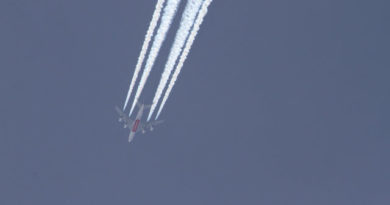A video of a former CIA director is not proof that the government is spraying the sky with chemicals

The conspiracy theory that the U.S. government is intentionally spraying toxic chemicals into the air has persisted for nearly two decades.
The baseless claims often refer to so-called “chemtrails” and say that the condensation trails behind airplanes are part of an atmospheric spraying program meant to depopulate the world.
A new, related claim says the government has admitted to the spraying, citing a video of former CIA Director John Brennan.
A man in a video shared April 14 on Facebook said he was following up on a previous post about “the sprays that they’re putting in the air.” Those sprays are “designed to stunt the growth of your crops” and “to keep you lethargic, to keep your brain not functioning properly.”
He said video footage shows Brennan “telling you exactly what the government is doing.”
The man showed a clip from Brennan’s 2016 speech on global security threats at the Council on Foreign Relations. Brennan talked about stratospheric aerosol injection, one method of solar geoengineering that he said could help reverse global warming.
The Facebook video’s narrator then said, “The cat is out of the bag right? … Our own government is acknowledging that they’re spraying the skies.”
This post was flagged as part of Meta’s efforts to combat false news and misinformation on its News Feed. (Read more about our partnership with Meta, which owns Facebook and Instagram.)
But Brennan did not say the government is spraying the sky with toxic chemicals. He discussed the benefits and downside of one possible climate intervention that has not ever been and is not currently in use. During the speech, Brennan acknowledged, “As promising as it may be, moving forward on (stratospheric aerosol injection) would also raise a number of challenges for our government and for the international community.”
Stratospheric aerosol injection is a proposal for cooling the climate by injecting small particles, or aerosols, into the atmosphere about 10 miles above the Earth’s surface, said Chris Field, a Stanford University professor and director of the university’s Woods Institute for the Environment.
The theory is that the particles would reflect sunlight back into space, reducing global warming. The particles could be sulfur dioxide or calcium carbonate, Field said. Both are naturally occurring chemical compounds.
“The evidence that this could cool the climate is strong, based on observations of past volcanic eruptions, our basic understanding of atmospheric chemistry and physics, and lab experiments,” said Field, who chaired a 2021 National Academies of Science report on solar geoengineering research. “There are still many unknowns, reflecting limited experimentation.”
Nature’s version of stratospheric aerosol injection is a strong volcanic eruption that injects dust particles and gas, such as sulfur dioxide, into the stratosphere, said Kevin Trenberth, a National Center of Atmospheric Research distinguished scholar.
In 1991, the eruption of Mount Pinatubo in the Philippines resulted in about 20 million tons of sulfur dioxide into the stratosphere, according to a fact sheet from the United States Geological Survey. That caused global temperatures to drop by about 1 degree Fahrenheit for two years, from 1991 to 1993.
The U.S. government isn’t currently using stratospheric aerosol injection, Field said.
“In the U.S., there are no research teams exploring this technology” with experiments outside laboratories, Field said. “The U.S. government does not have a coordinated research program on (stratospheric aerosol injection).”
There have been a few attempts by private researchers to disperse sunlight-reflecting particles outside of labs.
A 2021 geoengineering experiment in Sweden by Harvard researchers was called off amid opposition from environmentalists. That experiment also has been the subject of false claims.
Last year, Make Sunsets, a private company, released weather balloons in Baja California, hoping to emit a small amount of sulfur dioxide in the stratosphere. The company didn’t track the balloons, but the Mexican government subsequently issued a ban on solar engineering experiments. Private researchers in the United Kingdom tried a similar small-scale venture last fall designed to test equipment, but results haven’t been published, according to MIT Technology Review.
Legislation signed in 2022 directed the White House Office of Science and Technology Policy and relevant federal agencies to draft a five-year research plan for solar radiation modification research, which could include stratospheric aerosol injection, a spokesperson for the agency said.
The report will not be new research, the spokesperson said, but will highlight knowledge gaps and priority research areas to advance understanding of the field.
The spokesperson said the U.S. government is engaged in a limited subset of research in this field, which includes modeling and laboratory research. No federal research activities involve field testing, deployment, outdoor experimentation or releases of materials into the atmosphere, he said.
Climate experts appear divided on this form of climate intervention because of possible unintended consequences. But many agree it’s a subject worth researching.
A Facebook post claims that video footage of Brennan proves that “our own government is acknowledging that they’re spraying the skies” with toxic chemicals.
In the 2016 footage, Brennan talked about stratospheric aerosol injection, one of several proposed climate interventions. It was not in use then and Brennan did not say it was. It is not in use now, either.
We rate the claim False.
This fact check was originally published by PolitiFact, which is part of the Poynter Institute. See the sources for this fact check here.


